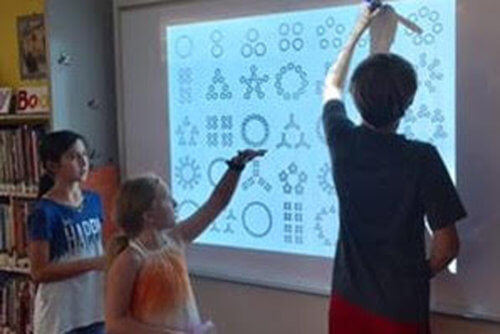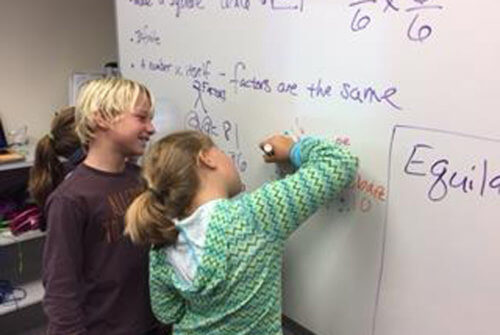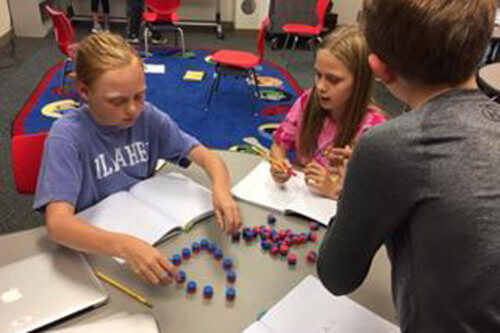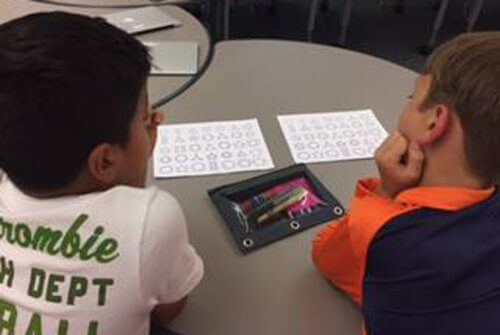 My elementary school Math memories are all about timed tests and pressure to find the correct answer using the precise steps we were taught. My math lessons never inspired creativity or presented the challenge to discover multiple ways to solve a problem. So when I was introduced to Colorado Academy’s Math program, I was truly amazed at how students were encouraged to experience, explore, and play with numbers.
My elementary school Math memories are all about timed tests and pressure to find the correct answer using the precise steps we were taught. My math lessons never inspired creativity or presented the challenge to discover multiple ways to solve a problem. So when I was introduced to Colorado Academy’s Math program, I was truly amazed at how students were encouraged to experience, explore, and play with numbers.
In Lower School homeroom classes, students are working with their teachers and classmates in the Math curriculum called Investigations 3. With this student-centered curriculum, children practice math through collaboration, investigation, and problem-based learning. Students learn from their teachers and from one another, showing different ways to approach and solve problems. To express themselves mathematically, they are encouraged to use manipulatives, pictures, and words.
‘It’s to create excitement about math’
 Since becoming the Lower School Math Specialist three years ago, Mary Singer has augmented the math curriculum for our Third, Fourth, and Fifth Grade students through the creation of Math Club. When asked why she wanted to create Math Club, Singer is quick to smile and respond, “The purpose of Math Club is very simple. It’s to create excitement about math.” It’s a fun and collaborative way to help students experience math as a path to discovery. Math isn’t just about finding an answer and moving on, it’s about asking “why” and “how” while solving a problem. Math Club is about as far as you can get from my memories of timed testing and using only one way to find a solution.
Since becoming the Lower School Math Specialist three years ago, Mary Singer has augmented the math curriculum for our Third, Fourth, and Fifth Grade students through the creation of Math Club. When asked why she wanted to create Math Club, Singer is quick to smile and respond, “The purpose of Math Club is very simple. It’s to create excitement about math.” It’s a fun and collaborative way to help students experience math as a path to discovery. Math isn’t just about finding an answer and moving on, it’s about asking “why” and “how” while solving a problem. Math Club is about as far as you can get from my memories of timed testing and using only one way to find a solution.
Singer comes around once per rotation to the grade-level classrooms to invite students for that week’s club. Anyone can participate in Math Club, and at the beginning of the year, Singer encourages every student to try it at least once.
Math Club invites and encourages students to take a leap off the building blocks of math that they have learned in the classroom. It pushes them to use numbers to create and explore, and to discuss and debate their strategies and solutions to the challenges presented in that day’s club session. Singer gave a comparison that really resonated with my librarian heart—she compared learning about math to learning to read. To learn to read, students “put letters together to make words, then they put those words together to create stories. It’s the same idea for math. When they learn to add, subtract, and multiply, students are putting the basics together. Then when they see these building blocks in larger relationships, they can create stories mathematically.”
As Math Specialist, Singer doesn’t just want students to solve a problem and move on. She wants to challenge them to be creative with their solutions and to see the real-world applications of what they are doing—all while having fun. And that’s exactly what Math Club helps achieve.
Every child has the ability to think creatively
 During a visit last year, my dad observed a Math Club meeting that had Fifth Graders working with Upper School students. The multi-age group debated questions about the number zero: Is zero an odd or even number? Is zero a negative or positive number? My Dad was amazed by depth of thought that all of the students were sharing and their ability to listen to one another’s differing arguments.
During a visit last year, my dad observed a Math Club meeting that had Fifth Graders working with Upper School students. The multi-age group debated questions about the number zero: Is zero an odd or even number? Is zero a negative or positive number? My Dad was amazed by depth of thought that all of the students were sharing and their ability to listen to one another’s differing arguments.
From Singer’s perspective, this kind of cross-divisional collaboration is fun, because of the conversations Upper School students and Fifth Graders have about math and the thinking and problem-solving process. The Fifth Graders might not know how to solve the problems presented to them by the Upper school students, but they get to see where the math work they are doing now will lead them. As for the Upper School students, they get to look into the minds of Fifth Graders and see how far they have come since their Fifth Grade days. For them, it’s always a realization of “I used to think like ‘that,’ and now I think like ‘this’.”
 Every child has the ability to think creatively, and Singer knows that one challenge she faces is to get kids to apply that creativity to math and to be excited about doing it. Even kids who in the classroom don’t view themselves as mathematicians can come to Math Club and have success and get excited about math. Says Singer, “It’s an opportunity to have an entry point to math that’s fun for all levels of kids.”
Every child has the ability to think creatively, and Singer knows that one challenge she faces is to get kids to apply that creativity to math and to be excited about doing it. Even kids who in the classroom don’t view themselves as mathematicians can come to Math Club and have success and get excited about math. Says Singer, “It’s an opportunity to have an entry point to math that’s fun for all levels of kids.”
Math Club is about discovering: revealing the relationships between numbers and solutions, uncovering math and its role in the real world, and realizing that math, much like art, sports, and reading, is fun and creative. At CA, we strive to develop the whole child. That means rigorous academics, social and emotional health, and encouraging them to find fun, creativity, and fulfilment—whether it’s through competitive play with a team, creating on an untouched canvas, or something else—like exploring math.